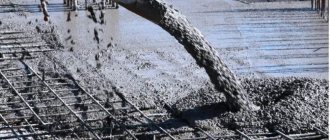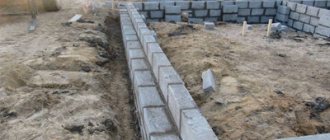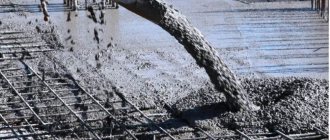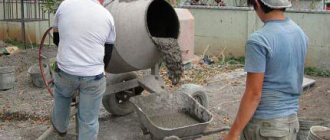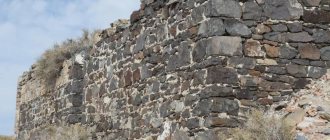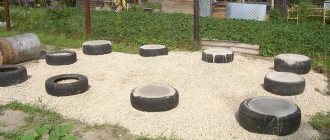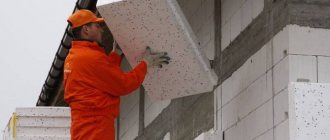It often happens that construction stretches over more than one season. The reason for this may be either the technology of construction work or a simple lack of time/resources/money.
My house was built first and took up the lion's share of the finances set aside and saved for construction. Our family did not have to rely on credit funds, since the interest on consumer loans is, to put it mildly, inhumane.
Naturally, adhering to the above philosophy, it was assumed that I would act according to the following plan:
- 1st year – pouring the foundation;
- 2nd year – construction of walls;
- 3rd year – roof installation;
And so it happened, in the first year there was barely enough finance to pour the foundation, so until better times he had to endure at least one winter. Then I thought, how can I save my work?
The answer came naturally - to cover the concrete for the winter in order to protect it as much as possible from the aggressive external environment.
The story was shared by my subscriber Arthur.
Preserving the foundation in winter: options
To ensure that the foundation of the future house, previously poured and completely ready for further work, does not crack over the winter, it can be preserved in one of several ways:
- cover with thick construction film, sprinkle soil on top and press down with stones;
- protect from excess dampness and water using drainage;
- make additional waterproofing on all sides of the base of the house;
- cover the base of the building with one of the types of greenhouses;
- insulate the outer sides of the foundation with polystyrene foam, and backfill with non-metallic material in a 20 cm layer with mandatory compaction of the soil.
Of course, each type of base requires its own conservation. But these methods can be combined and used for any ready-made base. After all, the main reasons for the destruction and deformation of the flooded foundation of a house are increased heaving, the proximity of groundwater and the lack of load on the foundation.
Having eliminated one or more causes of damage to the foundation during the winter season, you can safely leave the foundation of the house for the winter.
Features of thermal insulation with polystyrene foam
Insulating the base with polystyrene foam has many advantages:
- the material is not hygroscopic;
- Expanded polystyrene has no shelf life limitation;
- cheap price;
- has excellent hydro- and heat-insulating properties.
Thermal insulation with polystyrene foam
Before insulating the foundation of a house, you need to carry out the whole range of preliminary measures:
- first you need to remove all the soil located above the freezing level;
- it is necessary to clean the base from any remaining soil and debris;
- Now you can start waterproofing (bitumen in rolls or liquid rubber).
The procedure for waterproofing the base is as follows:
- concrete base slabs and plinth are primed with a special solution (the solution can be purchased in a store or prepared with your own hands by mixing melted bitumen and diesel fuel in a 1:1 ratio);
- after the primer has dried, you can apply a waterproofing material;
- if you had liquid rubber stored for these purposes, just mix it and apply it to the base with a spatula;
- If you decide to use rolled material as waterproofing, then before attaching it you will have to measure it, cut it vertically, roll it up and begin attaching it to the base slabs, while simultaneously heating the rolled edge with a torch.
Waterproofing and insulation of the base
The insulation is attached after the waterproofing has cooled down and hardened a little. Installation of polystyrene foam on the rolled material is done using the same burner, which heats some points and tiles and then presses them in these places. If the material is glued to liquid rubber, it is better to use a special mastic to secure it.
The final stage of insulation work with expanded polystyrene is backfilling the base and installing an additional roofing felt layer in the blind area.
What is conservation of construction for the winter?
So, individual housing construction projects, that is, private low-rise construction, are usually mothballed for the winter. Why does conservation not affect commercial construction sites (in particular, multi-storey buildings under construction), which, as we can all observe, continue to be built even in severe January frosts? Economic reasons play the dominant role here: the cost of a facility downtime for at least 1 calendar day reaches half a million US dollars (depending on the scale of construction), so technologists and engineers here do not skimp on materials:
Preservation of an unfinished house for the winter
- special components based on salts and polymers are added to the solutions to prevent water from freezing even at -40°C;
- the constructed structure is heated from the inside by special powerful heat guns.
We will tell you further how to do this correctly, so as not to expose the already erected structure to the danger of damage and destruction from frost, and also to avoid simply overpaying for the measures taken.
Concrete preservation methods
With the right approach, you can maintain the integrity of the pour and help the concrete solution achieve the required degree of hardness. With the arrival of the thaw, you can immediately begin construction of the building.
To accurately determine the concrete preservation method, it is necessary to take into account several factors that directly influence the choice.
It is necessary to make sure that the perimeter of the constructed structure is completely insulated and lined with vertical and horizontal waterproofing.
If the top layer of heaving soil was removed, completely replaced with a compacted sand embankment, or a clay hydraulic lock was laid around the perimeter of the future structure, plans can change dramatically.
There are two ways to preserve any type of base.
Protection with waterproofing and thermal insulation will prevent direct moisture from entering the concrete and will partially protect it from frozen soil. The insulation does not heat, but will prevent the fill from freezing.
For waterproofing, dense reinforced polyethylene or roofing felt sheets are used. It is better to use both options - lay roofing material down, film on top, or vice versa.
On top of the laid canvases they place oppression - bricks, foam blocks, which will prevent the material from being blown away by the wind.
The way to protect the foundation from water is to assemble a drainage system. You can prevent the destruction of a concrete base or house.
It is necessary to properly organize ditches and drains at the right points. Drainage points should be located no closer than 5 meters from the base. In a given sector, a large depression, 2 m wide, is dug to collect moisture.
Ditches are laid along the perimeter of the excavated space, with a depth and excavation width of 50x50 cm. A similar action is carried out along the perimeter of the foundation.
It remains to form several drains that will lead the liquid from the foundation towards the collecting pit.
Consequences of lack of conservation of a construction site
To leave everything as it is and not carry out any work at all means to “kill” the construction site with your own hands, so it is simply necessary to carry out at least the minimum and easily accessible complex of protection for long-term construction. But it is worth considering that some events cannot be avoided, and some can be excluded to save money.
Conservation is a series of measures aimed at preserving an already erected structure from destruction when exposed to atmospheric factors, and it is not a bad idea to worry about the safety of the construction site for others. At the same time, conservation makes it possible to quickly put the object into construction in the spring without additional preparatory and restoration work.
Conservation itself implies drainage of water and protection from moisture of the construction site and stored materials purchased for future use. Without protective cover, building materials accumulate moisture, which, when frozen, destroys their structure. Moreover, even if at first glance, after defrosting, no damage is detected, it still exists: at a minimum, a decrease in the strength of the material due to microcracks, and at a maximum, subsequent rapid destruction (delamination).
Conservation of a construction site
For whatever reasons, the construction of the facility was suspended in the winter, it is necessary to carry out a set of necessary work to prepare for the conservation of the facility itself and the materials brought for construction.
Snow and frost can greatly damage the foundation
There are several reasons that can cause damage to prepared building materials and erected structures:
- Atmospheric precipitation - water from rainfall is absorbed into materials and accumulates in the cavities of building structures. With the onset of the first frosts, the water freezes and expands significantly, which can cause destruction of building structures and damage to materials.
- Low temperatures can cause deterioration in the properties of some building materials, which lose their properties and become very brittle. To prevent damage to material resources, it is very important to cover them correctly.
- Water and frost cause a phenomenon called soil heaving - frozen wet soil begins to push foundation structures to the surface of the earth. Shallow foundations suffer greatly from this phenomenon.
- Excessive snow load in winter can cause the collapse of building structures that are not designed to withstand a load of such force.
- The last reason in favor of conservation is not related to natural phenomena or the design features of the building. At a site unprepared for wintering, there is a danger of theft of materials that are not guarded by anyone during the winter period.
Features of conservation of foundations for a long period
If you understand that the construction of the building will be suspended for more than a year, then with the onset of construction you will have to partially re-open the foundation and perform additional work. For this:
- remove plastic film from all surfaces so that the concrete and masonry dry well during the summer;
- extend and make drainage lines according to a permanent work pattern;
- arrange a permanent blind area around the perimeter of the entire building;
- install a lightning drain at least 10 meters high, mount a drain from it and a grounding circuit;
- ensure reliable waterproofing of all vertical and horizontal surfaces.
In order to reduce the lateral pressure of the soil during heaving and maintain the thermal insulation properties of the material, use insulation for walls with a thickness of at least 100 mm. All these measures will allow you to preserve the foundation for up to 5 years without continuing construction.
Methods for protecting foundation structures
Proper conservation of the foundation before winter will not only preserve its integrity, but will allow the concrete to gain maximum strength over these months. As a result, it will be possible to begin the construction of walls with the onset of a thaw and thereby complete construction faster.
How to preserve the foundation for the winter? In order to ensure reliable high-quality protection of the foundation, the list of work performed should include:
- insulation of the building perimeter;
- presence of vertical and horizontal hydraulic insulation;
- replacing heaving soils with compacted dry sand;
- installation of a hydraulic lock along the entire perimeter of the building.
If the groundwater level is high, drainage pipes should be installed to ensure efficient drainage of water.
Insulation of foundations for the winter period
Since the most difficult operation to preserve the foundation of a house in winter is insulating it on each side, it is worth considering such work in more detail.
Such work should be carried out immediately after the foundation itself has dried, when the formwork is removed. Then you can not only leave the base of the house unloaded in winter, but also get warmer floors later, when the building is built.
The insulation process will look like this:
- polymer-bitumen mastic is applied to the vertical surfaces of the tape (supports, slabs) as a waterproofing layer - this will prevent moisture from spoiling the finished base;
- The vertical sides of the base are covered with expanded polystyrene slabs, using adhesive compounds for this - this will insulate the foundation and additionally protect it from damage;
- additional finishing of the slabs attached to the base is carried out using plaster - this will extend the service life of the foundation for many years;
- backfilling is carried out with non-metallic material in a layer of at least 18 cm with dense compaction.
Of course, the cost of materials and funds for such a foundation will be much greater than when creating a simple foundation. But the heat savings in the house during its operation will cover these costs in the first year of residence. And the likelihood of damage to the foundation from heaving is reduced to a minimum.
Materials and their properties
How to insulate the foundation so that you don’t have to freeze in winter? To do this you need to choose the right material. The optimal insulation for the base should have the following qualities:
- strength (in order to withstand high soil pressure, the insulation must have a low degree of deformation during compression);
- the insulation must retain heat, i.e. it must have a low degree of thermal conductivity;
- low level of hygroscopicity (otherwise the water that gets into the insulation, freezing in winter, will greatly increase in volume and deform the material).
Expanded polystyrene reliably protects the base of the building.
Insulation of the foundation from the outside can be carried out with the following materials:
- foam plastic, penoplex;
- polyurethane foam;
- extruded polystyrene foam.
All of the above types of insulation have high strength and durability, in addition, they are not hygroscopic and have low thermal conductivity.
It is not recommended to use mineral wool and simple polystyrene as insulation for the base and blind area, because they are highly hygroscopic and therefore subject to seasonal deformation, especially in winter.
Conservation of the construction of brick and block (foam block, gas block, shell rock) house
First floor without ceiling
Builders do not recommend winterizing the construction of a house at this stage. It is advisable that the walls already have a ceiling laid.
It is very important that there is a reinforcing belt along the top of the walls. If winter occurs at the construction stage, when the reinforcing belt has not yet been laid, then without protective measures water gets inside the bricks (or blocks), which leads to their destruction and guarantees efflorescence on the brick in the spring
If the wall is multilayer (well) and insulation is laid between the two walls, then remaining uncovered the insulation will absorb moisture, and the water in it will freeze and expand, which will completely destroy the structure of the material, and thereby render it unusable.
Therefore, preserving the house at this stage is labor-intensive and does not guarantee complete safety of the walls from getting wet and possible cracking.
If conservation is still necessary at this stage, builders recommend:
- Cover the top of the wall with waterproofing film, then load the film with bricks, or bend it in two directions, then press it against the wall with boards and nail it.
The same is done at the window sill level. Waterproofing walls - Free-standing walls erected above the floors must be braced (with struts or struts) if their height exceeds 3.1;
5.6; and 6.5 m with a masonry thickness of 38, 51 and 64 cm, respectively. Spacers - Inside the house, the floors are covered with straw mats (to protect the soil from freezing and heaving) and waterproofing film, the film is pressed with soil or sand to the walls from the inside, raising it by 20-30 cm.
- If there is a financial opportunity, then it is worth installing temporary lathing floors.
Place a waterproofing film or roofing felt on top of the sheathing and press it with bricks. Temporary overlap - There is no need to close the walls from the outside.
- Cover door and window openings with boards, sheets of metal, roofing felt or plastic film.
Windows and doors covered with plywoodWindows covered with roofing felt
Windows boarded up
- Water is removed from the house by leveling the surface of the site or using a ditch system (described above).
Protection of the first floor with overlap
This stage is more favorable for preservation for the winter.
Necessary activities:
- Lay waterproofing (roofing felt, PE film) over the ceiling, overlap it, seal the joints with adhesive tape, and securely load bricks on top from the wind. The edges of the hanging film are pressed against the wall with slats and nailed.
- Close door and window openings with boards, metal sheets, roofing felt or PE film.
- At this stage, it is already worth making a blind area that will protect the foundation from water flowing from the ceiling.
- Water is drained from the house by leveling the surface of the site or by installing a system of grooves described above.
The house has been roofed, the rafters have been laid, but not yet covered with roofing material
Rafter part without roofing material
At this stage, the walls were erected, the ceiling above the first floor and the staircase were laid, the gables were built, and the rafter structure was laid.
Preservation at this stage:
- It is necessary to protect the interior from moisture; for this purpose, a temporary lightweight roof is constructed. The sheathing is placed on the rafters, and waterproofing (roofing material, roofing membrane or reinforced PE film) is laid on it. The waterproofing is secured with wooden slats.
- If at this stage the gables have not yet been built, then these places need to be covered, for example, with plywood or boards to protect the waterproofing from blowing and the interior space from water and snow.
- Cover the openings with shields.
- A blind area and grooves are installed to drain water away from the house.
Features of insulation of pile foundations, strip and slab foundations
The technology of insulating a foundation slab is similar to the thermal insulation of a concrete floor on the ground. To do this, first of all, the soil is compacted, on top of which a geomembrane is laid, protecting the foundation from the capillary rise of groundwater. Next are the following layers:
- crushed stone-sand cushion, which increases the load-bearing capacity of the soil and correctly distributes the load;
- roll waterproofing;
- insulation, most often used polystyrene foam or penoplex.
There is a large selection of technologies for insulating strip foundations. Along with insulating the outside of the foundation with penoplex, the technique of permanent formwork, application of sprayed insulation, or finishing with expanded clay is used. Mineral wool is rarely used in this case due to its ability to absorb moisture.
If you choose the permanent formwork method, then it must be planned at the construction stage, because the thermal insulation materials used to insulate the foundation are an integral part of the structure.
For different foundations it is advisable to use different types of insulation
This is interesting! When performing permanent formwork, two issues are simultaneously resolved - insulation of the foundation both from the outside and from the inside.
Formwork is made from various materials, but most often the foundation base is insulated from the outside with penoplex or expanded polystyrene. Before starting work, it is necessary to make a recess from the compacted soil for the blind area, which is then filled in turn with the following materials:
- crushed stone;
- sand;
- waterproofing;
- insulation;
- formwork;
- reinforcing layer;
- concrete.
Equally important is the insulation of the base from piles or pillars. Of course, with a properly designed foundation of this type, it is no longer threatened by freezing forces or the damaging effects of soil moisture. However, there are a number of other, no less important issues that can only be solved by creating thermal insulation.
Schematic example of insulation of a strip foundation
Reinforced concrete gratings or post piles require thermal insulation, which must be no less than the base of the strip. It is important to understand that piles are often connected to a monolithic reinforced concrete grid, which, without proper insulation, becomes a powerful refrigeration element. A characteristic feature of a foundation on piles is the presence of a gap between the ground and the ceiling of the first floor, where utilities are usually laid.
Insulation of a pile-screw foundation of a wooden house is most often accompanied by decorative finishing of this part of the facade. In any case, the space between the house and the ground will be closed on all sides and will not become a place for dirt or debris to accumulate. Measures to insulate a pile-screw foundation are also necessary to ensure comfortable living, increase the service life of the building and improve the appearance of the structure.
Stages of preserving the foundation for the winter
According to the general opinion of construction specialists, interrupting construction at the foundation stage is even more profitable and useful, because During the period of inactivity, the foundation will gain greater hardness and give uniform natural shrinkage. Therefore, conservation of the foundation is useful, but abandoning it to the mercy of fate in the rain and frost is not acceptable.
Preservation of the foundation for the winter implies:
1. Providing thermal insulation
– optimal stage of foundation conservation, i.e. even a slightly damp base with reliable thermal insulation will not freeze until internal forces of self-destruction form. Moreover, having reliable thermal insulation, you can leave even a wet foundation for the winter, because the chemical processes of concrete hardening are accompanied by the release of heat, which does not allow the foundation to freeze even in severe frosts. But even good thermal insulation without reliable waterproofing becomes a useless operation.
2. Ensuring waterproofing is the most important point that cannot be avoided. Excessive accumulation of moisture in winter leads to accelerated destruction of the foundation. Water, even without freezing, successfully destroys fresh concrete structures due to the “washing out” of the binder component. A wet foundation acquires a porous soft structure that is unable to cope with external influences. Therefore, continuous waterproofing is an integral stage of conservation.
It is worth paying attention to the fact that “dry” foundations are completely waterproofed (horizontal and vertical), but “wet” foundations must be waterproofed without an upper horizontal preservative layer. It is necessary to leave an “open” area of the structure for the evaporation of excess moisture, which is protected from precipitation by leaky “capes” of waterproofing
3. Groundwater drainage
or measures to prevent flooding - a recommended measure especially in the stages of lack of thermal and waterproofing. But when performing reliable hydro- and thermal insulation, this is an unnecessary operation, because... It is more expedient to backfill the foundation. But in cases where there is a further need to carry out work on the foundation in the spring, this event becomes extremely necessary.
At a distance of a meter along the perimeter of the foundation, a compacted trench measuring 50*50 cm is made, and a blind area from the foundation must be made in its direction, along which water will flow into the ditch. But the volume of the “channel” will not be enough, so it is necessary to dig several improvised reservoirs to the side to accumulate water, or significantly expand and deepen the ditch itself.
It is also important to take care that there is no accumulation of water on the internal foundation area. Why are drainage systems also used? • If there are sewer channels in the foundation, then the layout is carried out so that they are used to drain wastewater outside into the trench
• If there are sewer channels in the foundation, then the layout is done in such a way that they are used to drain wastewater outside into the trench.
• If it is not possible to drain wastewater outside, a drainage hole is dug in the center of the foundation site.
It is worth noting that when constructing foundations with utility basements, it is imperative to organize external drainage, for which drainage systems are taken into account at the design stage.
Thermal insulation of the base of a wooden house
Insulating the foundation in a private wooden house is a mandatory procedure if the foundation box is in direct contact with the ground.
Usually there is a huge amount of free space left inside the dug pit. If this place is not planned for a basement, then it would be more rational to fill it with expanded clay or just earth up to the floor level.
Insulating the foundation with your own hands with earth has both pros and cons. Undoubtedly, this is the cheapest, frankly free, material, plus, it does not need to be mined, because it remains in large quantities after digging a trench for the foundation. The negative side of this method of insulation is the complexity of the backfilling procedure, because most of the soil will have to be filled in manually, as well as the low degree of thermal insulation, which will be especially noticeable in the cold winter.
Thermal insulation with expanded clay
An advantageous alternative to this method of insulation is filling with expanded clay. Firstly, you don’t need much material, because not all the free space is covered with it, but only 50 centimeters of the inner walls of the foundation wasteland.
Secondly, the opportunity to make a basement and hide elements and communications nodes there. In addition, expanded clay can also be used to insulate the blind area.
Expanded clay insulation consists of the following stages:
- digging a trench;
- installation of permanent formwork made of slate, boards, etc. around the perimeter of the walls;
- laying waterproofing material inside the formwork and on the basement walls;
- filling of expanded clay;
- covering expanded clay with a layer of roofing material, backfilling, arrangement of a blind area.
Preservation of building materials in winter
It is very important to preserve all materials that were brought to the site but not used for any reason so that they are not destroyed by the weather.
All lumber is stacked on pads. Storing lumber When storing them, try to leave about 5 mm of free space between them, which will give them the opportunity to ventilate. This will allow the wood to get rid of excess moisture reserves. All wood materials should be treated with antiseptics (except for those that you plan to use, for example, for formwork). They need to be covered on top with plastic film or roofing felt.
All under-roofing materials, materials for waterproofing cellars, roofing materials for covering roofs should be stored indoors, in a dry place, where you can also leave nails or other fasteners, glass and metal parts
It is important that rolled waterproofing materials (tar paper, roofing felt, PVC membrane) are stored in a vertical position, otherwise they will crack at the bends (usually closer to the middle of the roll). Storage of waterproofing
Paints, drying oils, etc. Solvent-based materials should be stored in tightly closed containers. Cement, lime, gypsum, alabaster are afraid of moisture, and it is better not to leave them on the site for the winter, but if there is no other choice, then they are stored indoors (sheds, for example, or cabins)
These materials can be placed in bags on the floor if the floor is dry. Any entry of moisture or excessive dampness into the room will lead to hardening and further unsuitability of these materials. Spoiled cement
Bricks that are to be used for laying stoves are best stored in a dry place. The rest of the unused bricks should be stacked, covered with film on top to protect the material from snow and water. The same goes for blocks. The sand is placed in a heap inside the formwork to protect it from spreading. The top of the sand should be securely covered with a strong film (for example, reinforced with polyethylene or roofing felt), and weighted with bricks from the wind. Waterproofing also helps protect the sand from moisture and prevent grass from growing in it in the spring.
Containers, water barrels, and a concrete mixer available on the site should be turned upside down to prevent them from being torn apart by frozen water in winter, or brought indoors.
You can get acquainted with conservation from a regulatory point of view by using the document: TKP 45-1.03-165-2009 “Preservation of objects under construction.”
Preserving the structures of an unfinished house for the winter and preserving building materials constitute a small part of the cost of the entire house. If conservation is carried out correctly, there will be no problems when using the house in the future. By following the rules for preserving an unfinished house, you will be able to continue construction next season without fear of a pitfall on the part of materials and structures.
Tape
How to preserve a strip foundation? The main point before starting conservation is to dismantle the formwork, because it is made of wood and during the autumn rainy season it will absorb a significant amount of moisture, which the concrete will then absorb.
Next, waterproofing is installed using roofing felt, waterproofing and reinforced film. The material used is laid on the foundation with a margin so that there are no gaps. The waterproofing material is secured on top with stones or other weighty structures.
The strip support is insulated. To do this, the structure is covered with a slab of polystyrene foam or polystyrene, and then covered with a thick film.
Moisture removal. You need to dig a small pit at a distance of 3-5 m from the concrete base and dig a couple of trenches leading to this hole, through which water will flow.
Preservation of the foundation for the winter
For safe wintering of the foundation, its construction must be completely completed. Here are the main steps:
- Make a double geotextile wrapping of perforated pipes in drainage wells.
- Before pouring, build drainage and bedding under the leveled area.
- Dig a well to drain drainage water. It must be deeper than the base of the foundation and located no closer than 4 meters from the construction site.
- Lay roofing felt or special foundation films in several layers under the foundation.
- Fuse a Bikrost-like material onto the walls and top edges. Carefully cover all cracks with mastic or plaster open surfaces with a moisture-resistant mixture.
- At a depth of 30-40 cm, lay hard foam plastic under the blind area. They also cover the outer surfaces.
- Sand or crushed stone should be poured into the space around the formwork and on top in a layer of 20 cm. It is advisable to compact it using a vibrating plate.
Since snow is a good natural insulator, you can install wooden slabs vertically - they will retain the snow. But if winters in your region are associated with thaws, the disadvantages of such work may outweigh its advantages.
Whether it is possible to leave the foundation for the winter also depends on the type of monolithic structure. The slab, if waterproofed and insulated, usually easily tolerates all uneven deformations of the soil. With tape everything is much more complicated. The area between the ribbons becomes the “pool”. The tape itself warps and twists due to swelling of the soil. Therefore, a number of additional actions need to be taken with the strip foundation:
- Disassemble the formwork around the tape. Swollen boards only contribute to waterlogging of the concrete.
- Cover and seal all surfaces with waterproofing.
- Insulate the blind area with polystyrene foam.
Due to the fact that there is no house yet, there is no heat source and peripheral thermal insulation is ineffective.
Without thermal insulation it is impossible to preserve the structure
Here are some more tips on how to protect your foundation from moisture and low temperatures in the winter:
- Place straw, spruce branches, branches or sawdust on top of the tape, and cover the top with film.
- Plow and harrow the ground. Loose soil is a good heat insulator and concentrates more water without letting it pass into the depths.
- Install snow-retaining boards from boards. This will have a positive effect if the snow does not melt during the winter.
- It will not be possible to protect the space between the tapes from water. Therefore, film-covered wooden slabs are installed with a slope on all sides of the tape.
A foundation without a building, left for the winter, can be compared with the foundation of unheated buildings. And for them, a 5 cm layer of polystyrene foam is used under the entire foundation, the blind area is insulated with the same material to a width of about a meter, and a layer of 10 cm is placed at the corners of the blind area.
Insulation of a slab foundation
Of course, if the house is designed for further year-round living, it is not economically feasible to spend so much heat insulation on the foundation. Therefore, the main thing is to ensure high-quality thermal insulation and drainage of groundwater. The blind area is done after finishing the walls.
If construction cannot be continued next season, the facility will still be re-opened in the spring so that the concrete dries completely during the warmer months. In the fall, the quality of waterproofing and the operation of the drainage system are checked. All violations are corrected and closed again for the winter.
It is estimated that a foundation that has stood for one season without being closed loses up to 20% of its strength. Thus, if it stands open for 5 years, it will become completely unsuitable for building a house.
How to close the vents in the foundation for the winter?
A few words about the foundation of a house already built in winter. High humidity is present in any structure located near the surface of the earth. A strip foundation that is well insulated and drained still accumulates excess moisture because it is not heated, but it maintains a positive temperature in winter. This causes wooden beams to rot and concrete to become damp.
To solve this problem, vents are made in the foundation strips. They are located above the snow level. Ventilation also saves from the accumulation of radon gas in the basement. Excess radon can lead to radioactive contamination of the entire home.
Many people try to protect the basement from freezing by covering the vents with various heat insulators. Should not be doing that. The drier the air in the underground, the better the basement retains heat. This means there will be a good microclimate on all floors.
What is foamed polyurethane foam, how is it used to insulate the foundation
Do-it-yourself insulation of the foundation of an already built house has recently become popular with the help of foamed polyurethane foam, which is characterized by excellent consumer qualities. The only disadvantage is the need to use a special installation during application, in which the polyol and isocyanate are mixed under pressure, after which the synthesis of the polymer begins. During the reaction, carbon dioxide is formed, which creates bubbles that are separate from each other. Spraying is carried out in a thin layer on a previously cleaned and prepared base.
Before insulating the foundation, it is recommended to familiarize yourself with the positive and negative qualities of the material:
Foamed polyurethane foam is used for insulation of already constructed buildings
- Excellent thermal insulation properties, which are improved due to the presence of carbon dioxide bubbles, because the thermal conductivity coefficient of polyurethane foam is slightly lower than that of air.
- Resistant to mold and fungal growth.
- Continuity of the applied layer without gaps, joints, cracks or seams.
- Light weight, which allows the solution to be used on houses with any type of foundation. At the same time, high strength, rigidity and elasticity.
- Easy repair. If a certain area is damaged, it can be easily cleaned and filled with a new portion of polymer.
- Quick application. Spray insulation takes no longer than one day to complete.
In addition to the need to use special means for application, the disadvantages include the high cost of the material and the inability to carry out the work independently.
Frost protection used for long-term preservation
If construction is expected to be frozen for a long period, the facility should be re-opened upon the onset of spring.
Here is another addition to the article in the video:
As a result of this, excess moisture will evaporate and the foundation elements will dry out.
The structure is prepared for the next onset of winter as follows:
- Drainage sewerage is being laid;
- Engineering systems are being fastened;
- The grounding loop is extended;
- A waterproofing coating is laid on all concrete surfaces;
- Horizontal and vertical insulation is installed;
- Backfilling is carried out using non-metallic material.
Share this article with your friends on social media. networks!
Application of polyurethane foam
Application of polyurethane foam
To insulate the foundation of a house outside or inside, you can use polyurethane foam.
Polyurethane foam has many positive qualities, the main ones of which are:
- the method of its application is spraying, during which the material fills the most microscopic cracks and seams (layer thickness is about 5 cm);
- high adhesiveness, which allows it to adhere perfectly to any surface material.
The material is blown directly onto the concrete base slabs, after which waterproofing is applied to it and the base is backfilled with soil.
However, this procedure is quite expensive and requires knowledge of material application techniques and special equipment. Therefore, it will not be possible to insulate the foundation with your own hands using polyurethane foam.
How to protect the foundation from groundwater?
Protecting the foundation from groundwater and precipitation is the most important stage of the work. To do this, you should make gutters (ditches) to drain water
You should also pay special attention to the drainage of rainwater (and that formed as a result of melting snow). To create channels and gutters for water drainage, low areas should be identified near the foundation (within a radius of no more than 4 m) along its entire perimeter
At such points, holes are dug to a depth greater than that of the foundation, and about 2.5 m wide. Such holes will collect water from the foundation. From the perimeter of the foundation to these holes, ditches are dug with a depth equal to that of the foundation depth. To prevent ditches from crumbling or becoming clogged, gutters can be laid at their bottom and the walls can be reinforced (for example, with wooden formwork). The number of outlet ditches must be such that there are at least 3-4 outlets from each wall. At the same time, in winter, it is necessary to monitor the ditches so that they do not freeze and clog the water outlet. An important point is the location of the vents. Vents should be approximately 0.5 m above the bottom of the outlet grooves.
The final process is to provide the foundation with a load (this is especially true for shallow foundations). This is done to ensure that the foundation is “settled”. To do this, it is enough to place all the building materials on a covered foundation.
Video description
You can get acquainted with the features of polystyrene foam insulation technology in the video:
Insulation with sprayed polyurethane foam
Among all polymer insulation, sprayed polyurethane foam is the most expensive type. Its advantage is that the thermal insulation layer has no seams, and foamed polyurethane has very good adhesion to all types of building materials.
Application of polyurethane foam to a surface cleared of dirt is very quick. There are two types of materials: two-component and one-component.
In the first case, professional equipment is needed, the work of which is to supply both components under pressure to the working head, where they are mixed and foamed.
Single-component polyurethane foam is produced in liter aerosol cans, and even an untrained beginner can handle them correctly. But this technology is good for a small area of work, or when it is necessary to apply a small layer up to 2 cm thick.
Spraying polyurethane foam is similar to painting with a spray gun, so it is better to cover the cladding of the house. Source ppuspb.ru
If the soils are dry, the water level is low and proper drainage work has been carried out, then waterproofing of the foundation and base need not be carried out - there are no seams, and the water absorption of hardened polyurethane foam is small (no more than 2%). When finishing the base with plaster, reinforcement is not necessary - there are no joints, like with foam plastic slabs, and, therefore, there are no prerequisites for cracks to occur.
In addition to the price, polyurethane foam has one more small drawback, which is a consequence of its advantage - good adhesion. When carrying out work on insulating the basement, it is necessary to protect walls that already have finishing (or do not require it) - this is easier than cleaning off hardened foam.
Insulation with expanded clay
Recently, this bulk material is rarely used for foundation insulation. Its use is limited by two factors: quite high, compared to polymer insulation, water absorption and thermal conductivity.
The thickness of bulk thermal insulation can reach 60 cm Source obustroeno.com
The first indicator lies in the range of 8-20% of the volume. Moreover, such water absorption is typical for “fresh” expanded clay - over time it becomes even higher. For comparison, for ordinary polystyrene it is no more than 4%. Therefore, waterproofing of both the foundation and the entire insulation layer is necessary.
It is impossible to ensure complete “tightness” of expanded clay, and it will take a long time to dry underground, wrapped in film - its use is not recommended in conditions of high seasonal rise of groundwater.
Thermal conductivity also does not meet modern requirements for thermal protection of buildings - 0.07–0.18 (W/m*°C) versus 0.02–0.04 for polyurethane foam, 0.03–0.04 for EPS/EPS. Therefore, the recommended thickness of bulk thermal insulation for our middle latitudes lies in the range of 40–60 cm.
The insulation scheme looks like this:
- dig a trench of the estimated width (or clear the cavity of the pit) to the heel of the foundation;
- lay a waterproofing film over the entire area of the trench - foundation-bottom-wall;
- fill and level expanded clay;
- cover with film on top;
- pour a layer of sand;
- make a blind area.
Typical scheme for insulating a foundation with expanded clay Source sevparitet.ru
The advantage of expanded clay is its environmental friendliness and low price. Although, taking into account waterproofing and a large volume of materials, the cost of work in the end will not be so low. In addition, the base will have to be insulated using one of the above methods.
Foundation conservation work
The process of preparing a poured foundation for the upcoming winter period depends on its type and design.
It is important to follow the sequence of steps and procedures, since even minor deviations from mandatory technologies can lead to devastating consequences
Strip foundation
This type of foundation is one of the most susceptible to destructive effects from swelling soils, as well as high humidity and low temperatures. Therefore, preservation of the strip foundation for the winter is necessary, and in order to protect the foundation for the winter, several types of work should be performed, the main of which are:
- mandatory removal of formwork, since wood attracts moisture and then transfers it to concrete;
- waterproofing of the entire structure, for which different materials can be used: plaster, coating, primer, roofing felt, etc.;
- construction of a drainage system, and it is recommended to do it while working on the foundation (but it can be done immediately before conservation);
- insulation using polystyrene foam, polystyrene or other suitable materials, followed by covering with reinforced film.
In any case, it is necessary that before preserving the strip foundation for the winter, it must gain strength for at least a month at positive air temperatures.
Monolithic slab
This type of foundation, left without load, is most susceptible to deformation, erosion and displacement in winter. Its vulnerability is due to the fact that due to its relatively small thickness, the entire structure is actually located in the zone of soil freezing.
The presence of a sand-gravel cushion and a waterproofing layer protects against soil water and swelling, but in any case it is impossible to leave the slab foundation unpreserved for the winter. It is necessary that before the onset of cold weather, concrete gains strength for at least 30 days at positive air temperatures.
Before leaving the base for the winter, it is necessary to protect not only its surface, but also the surrounding area from moisture. You can use film, waste slag, expanded clay, etc. You must first provide insulation - polystyrene foam, polystyrene, dry sawdust or sand are suitable for this.
Screw pile foundation
This type of base is least susceptible to moisture, low temperatures and swelling frozen soils. Pile structures can be erected both in summer and winter. They are used on weak, crumbling, swampy, etc. soils, as well as in areas with high groundwater levels.
Special preservation of the pile foundation for the winter is not required; the preparation technology may only include tying from rolled metal. You should also first check that the internal space of the installed piles is filled with concrete, and that it is desirable to have a cap on top.
Columnar foundation
Structures of this type are used primarily for the construction of relatively light buildings, for example, frame, wooden, panel houses. The peculiarity of such bases is that they have little contact with open air and soil.
They are practically not subject to destruction due to lifting forces from frozen soils. The only exceptions may be some types of shallow structures: in this case, uneven lifting of individual pillars is possible.
To prevent such damage, it is recommended to create a grillage. This will be the conservation process - but it should be borne in mind that this work must be completed before the onset of cold weather.
Concreting foundations in frosty conditions
Sometimes it is necessary to carry out work to create a foundation at a time when the air temperature is tens of degrees below zero. Or when concreting, the solution has not yet had time to dry, and frost is already setting in. In this case, there is no need to despair. You just need to perform a device called a heater, and calmly continue working as usual.
During winter concreting, the implementation of greenhouses becomes an indispensable operation. And although carrying out work in such a device is quite comfortable, the construction of the structure itself requires a lot of money.
Several types of greenhouses are used for winter concreting. Their difference is in the height of the structure. And the height depends on the degree of work performed.
Actually, a warm house is the same temporary hut. A wooden frame is built over the unfinished foundation. It is covered with thick film or plastic. The resulting building resembles an ordinary greenhouse, with a door for entry.
It is important to remember that if you do not cover the frame tightly with film, warm air will escape from the greenhouse. And the building will not have the desired effect.
Heat guns are installed inside the greenhouse, which will maintain positive temperatures. This allows you to get a well-seasoned foundation when concreting in winter.
Why protect the foundation?
Preservation of the base is necessary to maintain the integrity of the materials. In the absence of protective measures, partial destruction of the foundation walls is observed in winter. Due to severe frosts, the concrete becomes covered with cracks and cannot be restored.
If the groundwater in the area is located high, during rainy periods in late autumn and early spring the water will come into direct contact with the fill, causing subsidence of the base. The foundation pit may be damaged - the risk of erosion and collapses increases.
It is possible to prevent cost overruns for re-construction of the foundation if you address the issue of structural security.
Main tasks of foundation care
The process of caring for the foundation after pouring the concrete mass is to create optimal conditions for the maturation of concrete. The main tasks assigned to this process are the following:
Why care for the foundation?
- Minimizing plastic shrinkage of concrete.
- Ensuring high strength of the solution.
- Protection against premature drying.
- Protection against sudden temperature changes.
- Prevention of possible damage.
- Ensuring the durability of concrete.
It is worth noting that foundation care in summer and winter has significant differences.
Summer way to care for concrete
It is not recommended to deliver concrete mixture in the heat, so it is better to do it either early in the morning or in the evening, after the sun has set. The poured solution on a sunny day needs to be provided with additional protection. It is covered with roofing felt, slate sheets or other material suitable for this purpose.
Caring for concrete during rain is to prevent the solution from being washed away and holes from forming on the poured surface.
Clearly organized work throughout the concreting process is very important. When ordering ready-made concrete mortar from a construction company, make sure that its delivery to the construction site does not exceed 1 hour. Having received the concrete, it is necessary to pour it immediately to prevent it from quickly hardening.
Foundation care
Self-mixing should be carried out in accordance with SNP standards, and quickly poured into the place prepared for the base. In summer, cement mixtures dry much faster, so you can’t hesitate for a second. If you do not adhere to the rules, the concrete will be irrevocably damaged.
Caring for concrete in the summer requires constant moistening and compliance with all necessary measures to prevent the evaporation of water from the newly poured base. Such procedures are necessary because, in addition to high temperatures, there is also heat that the solution releases during hydration. Thorough watering is needed during the first three days after installing the foundation.
How often should you pour water on the foundation? This question is asked by many people who have virtually no knowledge of the rules for caring for concrete. If the air warms up to a temperature of more than 15 degrees above zero, then the concrete is watered once every 10-12 hours, and if the weather is windy, then every 2 or 3 hours.
In general, caring for a poured base is nothing more than maintaining normal humidity and temperature conditions during the hardening process of concrete.
